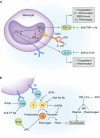Nonhuman primate species as models of human bacterial sepsis
- PMID: 30643274
- PMCID: PMC6613635
- DOI: 10.1038/s41684-018-0217-2
Nonhuman primate species as models of human bacterial sepsis
Abstract
Sepsis involves a disordered host response to systemic infection leading to high morbidity and mortality. Despite intense research, targeted sepsis therapies beyond antibiotics have remained elusive. The cornerstone of sepsis research is the development of animal models to mimic human bacterial infections and test novel pharmacologic targets. Nonhuman primates (NHPs) have served as an attractive, but expensive, animal to model human bacterial infections due to their nearly identical cardiopulmonary anatomy and physiology, as well as host response to infection. Several NHP species have provided substantial insight into sepsis-mediated inflammation, endothelial dysfunction, acute lung injury, and multi-organ failure. The use of NHPs has usually focused on translating therapies from early preclinical models to human clinical trials. However, despite successful sepsis interventions in NHP models, there are still no FDA-approved sepsis therapies. This review highlights major NHP models of bacterial sepsis and their relevance to clinical medicine.
Figures

Similar articles
-
Recombinant Fasciola hepatica Fatty Acid Binding Protein as a Novel Anti-Inflammatory Biotherapeutic Drug in an Acute Gram-Negative Nonhuman Primate Sepsis Model.Microbiol Spectr. 2021 Dec 22;9(3):e0191021. doi: 10.1128/Spectrum.01910-21. Epub 2021 Dec 22. Microbiol Spectr. 2021. PMID: 34937173 Free PMC article.
-
Klebsiella pneumoniae induces dose-dependent shock, organ dysfunction, and coagulopathy in a nonhuman primate critical care model.mBio. 2025 Jan 8;16(1):e0194324. doi: 10.1128/mbio.01943-24. Epub 2024 Nov 22. mBio. 2025. PMID: 39576068 Free PMC article.
-
Experimental models of sepsis and their clinical relevance.Shock. 2008 Oct;30 Suppl 1:53-9. doi: 10.1097/SHK.0b013e318181a343. Shock. 2008. PMID: 18704008 Review.
-
Nonhuman primate models for human disease.Adv Vet Sci Comp Med. 1984;28:267-304. doi: 10.1016/b978-0-12-039228-5.50014-0. Adv Vet Sci Comp Med. 1984. PMID: 6395673 Review.
-
Experimental primates and non-human primate (NHP) models of human diseases in China: current status and progress.Dongwuxue Yanjiu. 2014 Nov 18;35(6):447-64. doi: 10.13918/j.issn.2095-8137.2014.6.447. Dongwuxue Yanjiu. 2014. PMID: 25465081 Free PMC article. Review.
Cited by
-
Dissect the immunity using cytokine profiling and NF-kB target gene analysis in systemic inflammatory minipig model.PLoS One. 2021 Jun 4;16(6):e0252947. doi: 10.1371/journal.pone.0252947. eCollection 2021. PLoS One. 2021. PMID: 34086835 Free PMC article.
-
Staphylococcus aureus Host Tropism and Its Implications for Murine Infection Models.Int J Mol Sci. 2020 Sep 25;21(19):7061. doi: 10.3390/ijms21197061. Int J Mol Sci. 2020. PMID: 32992784 Free PMC article. Review.
-
Development, refinement, and characterization of a nonhuman primate critical care environment.PLoS One. 2023 Mar 17;18(3):e0281548. doi: 10.1371/journal.pone.0281548. eCollection 2023. PLoS One. 2023. PMID: 36930612 Free PMC article.
-
Viral and Bacterial Co-Infections in the Lungs: Dangerous Liaisons.Viruses. 2021 Aug 30;13(9):1725. doi: 10.3390/v13091725. Viruses. 2021. PMID: 34578306 Free PMC article. Review.
-
Organotypic heterogeneity in microvascular endothelial cell responses in sepsis-a molecular treasure trove and pharmacological Gordian knot.Front Med (Lausanne). 2023 Nov 9;10:1252021. doi: 10.3389/fmed.2023.1252021. eCollection 2023. Front Med (Lausanne). 2023. PMID: 38020105 Free PMC article. Review.
References
-
- Gaieski DF, Edwards JM, Kallan MJ, Carr BG. Benchmarking the incidence and mortality of severe sepsis in the United States. Critical care medicine. 2013;41:1167–1174. - PubMed
-
- Ferrer R, et al. Empiric antibiotic treatment reduces mortality in severe sepsis and septic shock from the first hour: results from a guideline-based performance improvement program. Critical care medicine. 2014;42:1749–1755. - PubMed
Publication types
MeSH terms
Substances
Grants and funding
LinkOut - more resources
Full Text Sources

